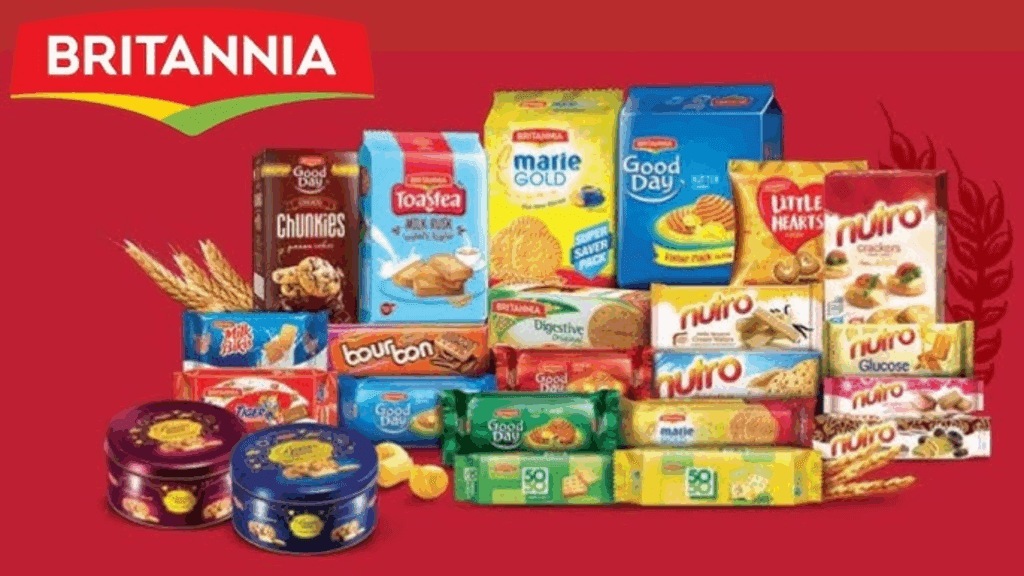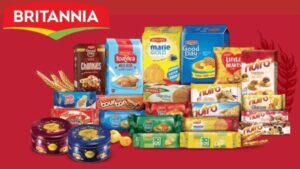1. At a Glance
Britannia Industries Ltd — India’s legendary biscuit baron — just dropped its Q2FY26 numbers, and once again, it’s giving competition a serious glucose shock. The company reported consolidated revenue of ₹4,841 crore with a net profit of ₹655 crore, a sweet 23% YoY rise. That’s a 20% Operating Profit Margin — the kind that makes even Parle hide its Krackjack behind a curtain.
At ₹5,892 a share, Britannia sits pretty with amarket cap of ₹1.42 lakh croreand a P/E of 61.3. That’s right — investors are paying sixty times earnings to own a piece of Good Day magic. ROE? A jaw-dropping 52.9%, proving that this biscuit is still loaded with cream, not air.
Over the last 3 months, the stock is up 7.6%, because apparently, calories and compounding are both irresistible. The Wadia Group’s crown jewel continues to hold 50.55% promoter ownership, zero pledges, and an empire of 28 lakh outlets that reach even the last chai stall on NH44.
And just when the oven couldn’t get hotter — the board appointedRakshit Hargave as the new CEO, effective December 15, 2025. Meanwhile, former RBI Governor Dr. Urjit Patel resigned to join the IMF. From biscuits to Bretton Woods — truly, Britannia has range.
2. Introduction
If India had a national biscuit, it would probably be Britannia’s Good Day — the official snack of awkward family visits and endless train rides. For over a century, Britannia Industries has fed generations with glucose, butter, sugar, and nostalgia — while quietly turning those crumbs into profits big enough to buy an actual bakery on Mars.
Founded in 1892 (yes, when Britishers still ran the railways and biscuit tins), Britannia has seenseven different owners, including a mysterious London investor before landing with the Wadias — the family that turned dough into dynasties.
Today, Britannia rules with an 80% revenue share from biscuits — thinkTiger, Marie Gold, Milk Bikis, NutriChoice, andGood Day, each brand with its own cult following. The company’s ₹18,488 crore annual sales empire stretches from Mumbai to Muscat, with biscuit dominance in India and a top-two position in UAE.
Despite competitors like Nestlé and Bikaji throwing their best snack punches, Britannia’s blend of premiumization, cost control, and nostalgia marketing keeps it at the top shelf — both in stores and in investor portfolios. And now, with its Ranjangaon dairy plant going full throttle, it’s not just about biscuits anymore; it’s about owning the chai-time ritual.
But here’s the real kicker: with an ROE north of 50%, this company converts nostalgia into net profit better than most FMCG majors convert milk into curd. Let’s decode the recipe that makes Britannia’s dough rise so consistently.
3. Business Model – WTF Do They Even Do?
Imagine a company that makes everyone from toddlers to CEOs snack at 4 PM — that’s Britannia.
Theircore businessis biscuits (about 80% of revenues). These range from glucose hits likeTiger, to premium cookies likeGood Day, to the “I’m healthy, but not really”NutriChoiceline.
Then comesbread— with 13 factories and 4 franchisees baking over 1 million loaves a day, delivering to 100+ cities. It’s a ₹450 crore business in itself. If you’ve ever made a midnight toast, odds are Britannia supplied it.
Thedairy division, though just 5% of revenue, is Britannia’s most exciting toddler. Products like cheese, milk beverages, and yoghurt are riding a 300% growth wave, with plans for 5 new facilities. TheRanjangaon plantin Maharashtra is now fully commercial, sourcing milk directly from 1,000 farmers — basically, vertical integration with a smile.
The company also hasinternational footprintsacross 80 countries and is the#2 biscuit player in UAE. Plus, there’s a greenfield project in Nepal — because apparently, even Mount Everest needs Marie Gold.
Britannia’s business model thrives ondistribution muscle: 30,000 rural distributors and over28 lakh outlets. Their goal? To make sure no tea cup goes lonely.
Add to that strong brand loyalty, smart pricing, and just the right level of guilt-free indulgence
— and you get an FMCG model that’s almost recession-proof.
4. Financials Overview
Quarterly Financial Comparison (₹ crore)
| Metric | Q2FY26 | Q2FY25 | Q1FY26 | YoY % | QoQ % |
|---|---|---|---|---|---|
| Revenue | 4,841 | 4,668 | 4,622 | 3.7% | 4.7% |
| EBITDA | 951 | 780 | 752 | 21.9% | 26.4% |
| PAT | 655 | 532 | 520 | 23.1% | 25.9% |
| EPS (₹) | 27.17 | 22.06 | 21.62 | 23.1% | 25.8% |
Annualized EPS = 27.17 × 4 = ₹108.68Current Price (₹5,892) → P/E = 54.2× (versus industry P/E 55.4×)
Witty Commentary:Britannia’s profits are growing faster than your waistline after Diwali. Despite modest sales growth, margin discipline and cost control have kept the bottom line buttery smooth. The 20% OPM is proof that Britannia knows how to bake inflation away.
5. Valuation Discussion – Fair Value Range (Educational Only)
Let’s bake three different valuation recipes.
(a) P/E Method:Annualized EPS = ₹108.68Industry average P/E = 55.4→ Fair value range = 45× to 65× earnings= ₹4,890 to ₹7,060
(b) EV/EBITDA Method:EV/EBITDA = 39.9×EBITDA (FY25 TTM) = ₹3,347 Cr→ EV = 3,347 × 39.9 = ₹1,33,555 CrSubtract Net Debt (~₹1,247 Cr) → Equity Value ≈ ₹1,32,300 CrPer Share Value = ₹1,32,300 Cr / 24.1 Cr shares = ₹5,490
(c) DCF (Simplified):Assuming 8% revenue CAGR, 18% OPM, and discount rate of 10% →Implied fair value range = ₹5,200 – ₹6,800
🧮Educational Fair Value Range:₹4,900 – ₹7,000
Disclaimer:This range is for educational discussion only and not investment advice. Don’t buy biscuits because your stomach or your broker told you to.
6. What’s Cooking – News, Triggers, Drama
If Britannia had a reality show, FY26 would be titled“Biscuits, CEOs, and a Billion Tea Cups.”
In Q2FY26,net profit hit ₹655 crore (+23%), led by improved product mix and margin recovery. But the boardroom oven has been sizzling too — CEORajneet Singh Kohli resignedin March 2025, followed by a corporate musical chairs session: CMO out in January, Head of Strategy gone by August, and now,Rakshit Hargave(ex-L’Oréal India) entering the kitchen as the new CEO in December 2025.
Also, former RBI GovernorDr. Urjit Patel resigned as Independent Directorin October 2025 to join the IMF. When even macroeconomists leave for

















